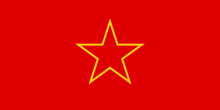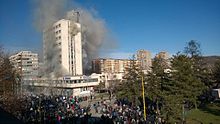Anarchism in Bosnia and Herzegovina
| Part of a series on |
| Anarchism |
|---|
 |
|
|
Anarchism in Bosnia and Herzegovina first emerged from left-wing currents during the Herzegovina uprising against the Ottoman Empire in 1875. This movement was spearheaded by the socialist Vladimir Gaćinović and received support from Bosnian and Italian anarchists, including Errico Malatesta.[1]
History[]
Under Austro-Hungarian rule[]

The establishment of Austro-Hungarian rule over Bosnia and Herzegovina eventually reached its apex with the country's formal annexation in 1908. Meanwhile, the May Coup in Kingdom of Serbia had led to a rise in Yugoslav nationalism in the Balkans. This culminated with the establishment of Young Bosnia, a revolutionary organization dedicated to the unification of Bosnia and Herzegovina with Serbia.[1] The group's ideological leader was Vladimir Gaćinović,[2] who was inspired by anarchists of the Russian diaspora, including the works of Mikhail Bakunin and Peter Kropotkin, as well as the actions of the Narodnaya Volya organization.[1] He proposed propaganda of the deed in the form of tyrannicide,[3] as a method of revolutionary political struggle to achieve Bosnian national liberation.[4] These ideas were first put into practice by Bogdan Žerajić, himself also a supporter of Kropotkin's ideas,[1] who attempted to assassinate the Governor of Bosnia and Herzegovina Marijan Varešanin, but failed and subsequently committed suicide.[5]
Žerajić's example was followed by several more attempted assassinations of Austro-Hungarian officials, the most significant of which was the assassination of Archduke Franz Ferdinand in Sarajevo. On 28 June 1914, members of Young Bosnia stationed themselves along the route of Franz Ferdinand's motorcade and one by one attempted on his life. The first attempt was by the Bosnian anarcho-syndicalist Nedeljko Čabrinović, who threw a bomb at the Archduke's vehicle, but it failed to detonate in time and Čabrinović's suicide attempt also failed.[6] Despite Čabrinović's failure, one of the Bosnian militants was successful - Gavrilo Princip shot the Archduke and his wife with a revolver, killing both.[7] At their trial, the Young Bosnians declared that the assassination was a reflection of their anarchist beliefs.[1] Čabrinović and Princip were both sentenced to 20 years in prison,[8] but the fallout from the assassination had already led directly to the beginning of World War I. In prison, the German psychologist Martin Pappenheim interviewed Princip about what drove him to assassinate the Archduke. Among the assassin's literature included a variety of anarchist works, including Kropotkin's The Conquest of Bread.[9] Princip and Čabrinović both died in prison from their illnesses, shortly before the war drew to an end.
Under the Kingdom of Yugoslavia[]
With the end of World War I, Bosnia and Herzegovina were unified into the Kingdom of Serbs, Croats and Slovenes, under the unitary rule of the Karađorđević dynasty. Shortly after the country's first democratic elections, the left-wing opposition was suppressed and future elections were marred by voter intimidation and the disfranchisement of ethnic minorities.[10] This brought about a period of governance by the national conservative People's Radical Party, but after the murder of a number of Croatian members of the government, the remainder withdrew from the National Assembly, preventing a new government from being formed. This led to the imposition of a royal dictatorship, in which King Alexander I reformed the country as the Kingdom of Yugoslavia, an absolute monarchy with the Yugoslav National Party acting as the sole legal political organization. This period of dictatorship ended in 1934, when Alexander was himself assassinated by Vlado Chernozemski.[11] This led to the rise of the fascist Yugoslav Radical Union as the dominant force in Yugoslav politics.[12] In 1941, the radical union was removed from power in a coup d'état which installed a national unity government concentrated around the military. But this government was soon forced into exile with the Invasion of Yugoslavia by the Axis Powers, which occupied and partitioned the country into various puppet governments centred in Croatia, Serbia and Montenegro.
World War II in Bosnia and Herzegovina[]

Bosnia and Herzegovina were brought into the new Independent State of Croatia, under the totalitarian rule of the fascist Ustaše and their leader Ante Pavelić. The regime pursued a campaign of genocide against the country's Serbian, Jewish and Romani people, as well as anti-fascist or dissident Croats and Bosniaks.[13] Over the course of the war, an estimated 316,000 people died in Bosnia and Herzegovina.
The Yugoslav Partisans resisting fascist rule in Bosnia and Herzegovina often found themselves cooperating with the Chetniks. The Bosnian partisan detachments were made up mostly of Serbs, even explicitly excluding Bosniak participation, up until 1942.[14] Nevertheless, many Bosniaks and Croats ended up joining the partisans themselves, making up 30% of the country's partisans by 1943.[15]
In 1943, the local State Anti-fascist Council established Democratic Bosnia and Herzegovina as the Bosnian component of Democratic Federal Yugoslavia, under the control of the League of Communists. This body coordinated the Bosnian partisan resistance up until the end of the war.
Under Communist rule[]

With the partisan victory in the war and the subsequent promulgation of the 1946 Yugoslav Constitution, the People's Republic of Bosnia and Herzegovina formed part of the new Federal Republic of Yugoslavia, governed by the League of Communists and their leader Josip Broz Tito. During the war, the league had taken steps to purge itself of "undesirable" elements that would dissent to the establishment of a dictatorship. Workers' organizations, including trade unions, were brought under party control, while natural resources and businesses were all nationalized. Opposition parties were persecuted following the communists' successful election, cementing single-party rule. Former partisans that had been forced onto collective farms revolted after a series of poor harvests, but this was repressed by the state which introduced a policy of requisitioning. In the 1950s, many workers began to implement socialist self-management, which the state allowed in a limited form.[16]
However, eventually the communist implementation of state capitalism reached a head, leading to a miners' strike in 1958. In the ensuing decade, over 2,000 subsequent strikes were held, but the communists' policy of media blackouts censored any mention of them in the official press. These were usually wildcat strike actions, as the country's sole official trade union refused to participate in strikes and any trade union members that did were purged from the union's ranks.[16]
Independence[]

The death of Tito and the subsequent breakup of Yugoslavia led to an armed conflict in the newly independent Republic of Bosnia and Herzegovina. The Dayton Agreement which ended the war partitioned the state between two federal entities: the Federation of Bosnia and Herzegovina and the Republika Srpska. The country was thus completely divided along ethnic lines, exacerbating the rise of nationalism and income inequality.[17]
This new status quo once again gave rise to anarchism within the country, after having been suppressed for nearly a century of authoritarian rule by various different parties. The rise of the Dosta movement from internet forums to public meetings brought about a form of libertarian organizing that transcended ethnic divisions. As it grew, it began to confront social and economic issues, even beginning to take direct action themselves.[17] After the Financial crisis of 2007–2008, a method of organizing around direct democratic assemblies known as plenums.[18] These plenums were one of the primary modes of organizing during the 2014 unrest in Bosnia and Herzegovina, in which anarchists participated.[17] The protests took on a fundamentally anti-nationalist character, with the slogan "Death to nationalism!" being graffiti'd on the walls of Sarajevo.[19]
See also[]
- Anarchism in Croatia
- Anarchism in Serbia
- Young Bosnia
- 2014 unrest in Bosnia and Herzegovina
References[]
- ^ a b c d e Indic, Trivo (27 May 1990). "The anarchist tradition on Yugoslav soil". Umanità Nova. Retrieved 17 October 2014.
- ^ Belgrade (Serbia). Vojni muzej Jugoslovenske narodne armije (1968). Fourteen centuries of struggle for freedom. The Military Museum. p. li.
- ^ Лесковац, Младен; Форишковић, Александар; Попов, Чедомир (2004). Српски биографски речник (in Serbian). Будућност. p. 634. ISBN 9788683651627.
- ^ Мастиловић, Драга (2009). Херцеговина у Краљевини Срба, Хрвата и Словенаца: 1918-1929 (in Serbian). Филип Вишњић. p. 35. ISBN 978-86-7363-604-7.
- ^ Ćorović, Vladimir (1992). Odnosi između Srbije i Austro-Ugarske u XX veku. Biblioteka grada Beograda. p. 624. ISBN 9788671910156.
- ^ Dedijer, Vladimir (1966). The Road to Sarajevo. New York: Simon and Schuster. p. 12. OCLC 400010.
- ^ MacMillan, Margaret (2013). The War That Ended Peace: How Europe Abandoned Peace for the First World War. Profile Books. p. 518. ISBN 9781847654168.
- ^ Owings, W.A. Dolph. (1984). The Sarajevo Trial. Chapel Hill, NC: Documentary Publications. p. 527–530. ISBN 0-89712-122-8.
- ^ Pappenheim, Martin (1916). "Conversations With Gavrilo Princip".
- ^ Balkan Politics, Time, 31 March 1923
- ^ "Alexander I | king of Yugoslavia". Encyclopedia Britannica. Retrieved 7 June 2019.
- ^ Payne, Stanley G. (1996). A History of Fascism, 1914–1945. University of Wisconsin Press. p. 325. ISBN 0299148742.
- ^ Fischer, Bernd J., ed. (2007). Balkan Strongmen: Dictators and Authoritarian Rulers of South-Eastern Europe. Purdue University Press. pp. 207–08, 210, 226. ISBN 978-1-55753-455-2.
- ^ Hoare, Marko Attila (2013). The Bosnian Muslims in the Second World War: A History. Oxford University Press. p. 23. ISBN 978-0199327850.
- ^ Hoare, Marko Attila (2006). Genocide and Resistance in Hitler's Bosnia: The Partisans and the Chetniks. Oxford University Press. p. 10. ISBN 978-0-19-726380-8.
- ^ a b Simic, Aleksandar (November 1995). "The workers' movement in Serbia and ex-Yugoslavia". Translated by Will Firth. Revolutionary Group TORPEDO. Archived from the original on 30 June 2012.
- ^ a b c "Anarchists in the Bosnian Uprising". CrimethInc. 18 February 2014. Retrieved 26 January 2021.
- ^ Katalenac, Juraj (6 February 2014). "What's up with Bosnia?". Insurgent Notes. Retrieved 26 January 2021.
- ^ Gavroche, Julius (31 March 2014). "All power to the plenums: Bosnia and Herzegovina's insurrection". Autonomies. Retrieved 26 January 2021.
- Anarchism in Bosnia and Herzegovina
- Anarchism by country
- Politics of Bosnia and Herzegovina
- Political movements in Bosnia and Herzegovina